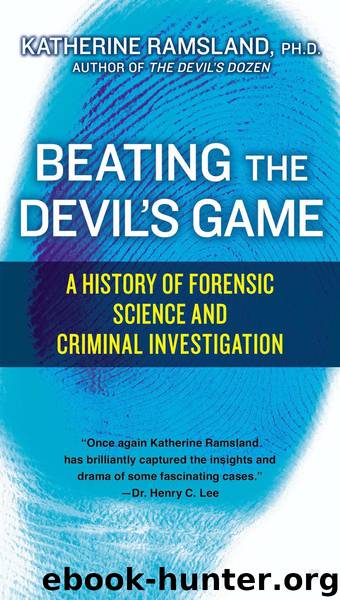Beating the Devil's Game by Katherine Ramsland

Author:Katherine Ramsland
Language: eng
Format: epub
Published: 2019-05-03T16:00:00+00:00
TWO
CHANGING SHIFTS
From Spies to Investigators
TOWARD SYSTEMATIC INVESTIGATIONS
As the 1700s came to an end, the University of Edinburgh had already thrown support to its practitioners of medical jurisprudence, and among them was Andrew Duncan, a professor of medicine who offered the earliest formal lectures on the subject in the English language. He even allowed members of the public to attend as a way to inject greater awareness into society. His aim was to urge physicians who participated in legal procedures to become more objective, systematic, and vocal in applying their knowledge of death and disease in the courtroom. The first formal chair in medical jurisprudence occurred in Edinburgh in 1807, with the establishment of the Forensic Science Institute. Duncan’s son, also named Andrew, was its first occupant, and Americans seeking to improve their own haphazard field of medical jurisprudence looked to the Scottish physicians for guidance.
By this time, German-born Englishman William Herschel had discovered infrared light beyond the red portion of the visible light spectrum, inspiring Johan Wilhelm Ritter, a Silesian physicist, to look for invisible light at the violet end. With a prism and reactions to silver chloride, he thus discovered “chemical rays,” or ultraviolet radiation, which would become a basis for identifying organic chemicals. Another Englishman, Thomas Bewick, viewed his fingerprints as identifying markers, but did not take the notion any further. Toxicology actually took the lead as a science applicable to criminal investigation when Dr. Valentine Rose showed in 1806 how arsenic could be detected in human organs. It was just in time for the sensational murder trial of a female serial poisoner.
Anne Schonleben neé Zwanziger, widowed at forty-nine, faced growing old alone and without money, so she hired herself out as a housekeeper in the hope of finding another man to marry. Her first target was Judge Glaser in Bavaria, who was married but separated. He seemed a good catch, but first Zwanziger worked to reconcile them to get access to the wife, whom she then poisoned. This left Glaser free to marry. However, he did not wish to marry Zwanziger, so she needed another plan.
She soon spotted a younger man who was merely engaged, and went to work on him. When he failed to respond to her, he died a ghastly death. Then another lawyer’s wife died of gastric distress, which got Zwanziger booted from that house as well. By this time, she was getting desperate and feeling rejected, so she left some “gifts” behind. In the salt boxes, she placed some white arsenic powder, which made the servants, the master of the house, and his baby violently ill. However, they all survived and given the fact that they’d all grown ill at once, Zwanziger finally came under suspicion.
The police got involved, exhuming corpses believed to have been earlier victims. However, they could not prove poisoning beyond merely observing the state of the organs, which in the case of arsenic poisoning should be fairly well preserved. That turned out to be the case with these victims, so the authorities went in search of Zwanziger, already on her way to another potential “mate.
Download
This site does not store any files on its server. We only index and link to content provided by other sites. Please contact the content providers to delete copyright contents if any and email us, we'll remove relevant links or contents immediately.
Mindhunter: Inside the FBI's Elite Serial Crime Unit by John E. Douglas & Mark Olshaker(9268)
Wiseguy by Nicholas Pileggi(5716)
Room 212 by Kate Stewart(5077)
Hitman by Howie Carr(5044)
Secrecy World by Jake Bernstein(4703)
Killers of the Flower Moon: The Osage Murders and the Birth of the FBI by David Grann(4411)
Papillon (English) by Henri Charrière(4230)
Breaking Free by Rachel Jeffs(4196)
Killers of the Flower Moon by David Grann(4001)
Say Nothing by Patrick Radden Keefe(3940)
American Kingpin by Nick Bilton(3823)
The Secret Barrister by The Secret Barrister(3666)
Molly's Game: From Hollywood's Elite to Wall Street's Billionaire Boys Club, My High-Stakes Adventure in the World of Underground Poker by Molly Bloom(3512)
Mysteries by Colin Wilson(3427)
In Cold Blood by Truman Capote(3349)
Signature in the Cell: DNA and the Evidence for Intelligent Design by Stephen C. Meyer(3103)
I'll Be Gone in the Dark by Michelle McNamara(3058)
Rogue Trader by Leeson Nick(3013)
Bunk by Kevin Young(2973)
